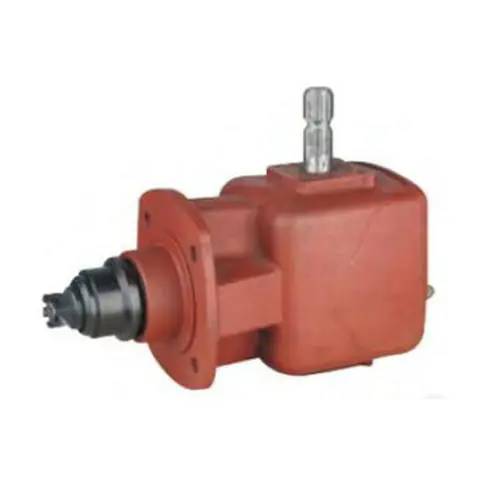Understanding PTO Shafts: Powering Agricultural and Industrial Machinery
2025-01-24
Power Take-Off (PTO) shafts are a crucial component in many machines, particularly in the agricultural and industrial sectors. These mechanical devices enable the transfer of power from a tractor or engine to an implement or machinery, making them indispensable for a wide range of operations. In this blog, we’ll explore the significance of PTO shafts, how they work, and why they are essential for heavy-duty equipment.
What is a PTO Shaft?
A Power Take-Off (PTO) shaft is a mechanical drive shaft used to transfer power from a power source, such as a tractor or engine, to an attached implement or machine. It acts as an intermediary link, connecting the engine’s rotating power to a piece of machinery that requires that energy to function.
For example, a PTO shaft may connect a tractor to a mower, baler, or snowblower, providing the rotational energy required for the implement to operate. It is essentially a way to extend the power from a vehicle or machine to other equipment.
Components of a PTO Shaft
A typical PTO shaft consists of several key components that work together to efficiently transmit power. These include:
1. Main Shaft: The central shaft that transmits the rotational power. It connects the power source (usually a tractor or engine) to the implement.
2. U-Joints (Universal Joints): These joints connect the different parts of the shaft and allow for flexibility in movement. They help transfer rotational motion while accommodating changes in angle, such as when the implement is raised or lowered.
3. Shield: A protective cover that encloses the shaft. The shield serves to prevent debris from interfering with the PTO shaft and ensures that operators do not come into contact with the moving parts, improving safety.
4. Yoke: The yoke is a part that connects the PTO shaft to the machine or implement. It allows for easy attachment and detachment of the shaft, making it adaptable for various pieces of equipment.
5. Slip Clutch: Some PTO shafts feature a slip clutch, a safety mechanism that disengages the shaft in case of overload. This helps protect the machinery from damage due to excessive torque or blockages.
How Does a PTO Shaft Work?
The operation of a PTO shaft is fairly simple, but its ability to transfer high amounts of power makes it a vital tool in heavy machinery:
1. Connection: The PTO shaft is attached to the power source (like a tractor) via a yoke. The tractor’s engine then generates rotational power that is transferred through the shaft.
2. Transmission of Power: As the engine rotates, the PTO shaft also rotates. This rotational motion travels through the shaft, its universal joints, and into the implement or machinery that is connected to the other end of the shaft.
3. Utilizing Power: Once the power reaches the implement, it drives the mechanical systems within the machine. For example, in a hay baler, the PTO shaft powers the machine’s rotating wheels or tines that gather and compress hay into bales.
4. Disconnection: After the work is done, the PTO shaft can be safely disengaged and removed from the power source and the implement, ready for storage or use with another machine.
Types of PTO Shafts
There are a few variations of PTO shafts, designed for different applications:
1. Standard PTO Shaft: These are the most common types of PTO shafts, typically found in agricultural and construction machinery. They are designed to handle moderate to high loads.
2. Heavy-Duty PTO Shaft: Used for industrial applications or high-load operations, these shafts are built to withstand greater stress and provide higher power transmission.
3. Telescopic PTO Shaft: Telescopic shafts have adjustable lengths, making them versatile for use with machinery that needs varying distances between the power source and the implement. These shafts are ideal for machines like mowers or snow plows that require flexibility in their setup.
4. Compact PTO Shaft: Designed for smaller machinery, these shafts are more lightweight and easier to handle but still capable of transferring sufficient power.
Applications of PTO Shafts
PTO shafts are used in a wide variety of industries, including agriculture, construction, and even marine applications. Below are some of the most common uses:
1. Agricultural Equipment: PTO shafts are often used to power implements such as mowers, plows, balers, harvesters, and tillers. These tools rely on the shaft’s ability to transfer power from a tractor or other engine to operate various mechanisms such as rotating blades or moving parts.
2. Construction Machinery: Certain construction machines use PTO shafts to operate auxiliary equipment, such as hydraulic pumps, cement mixers, or generators, directly powered by a truck or engine.
3. Industrial Machinery: In industrial settings, PTO shafts are used in machines such as conveyors, pumps, or grinders. They can also drive auxiliary systems on large machines, ensuring optimal operation.
4. Marine Applications: PTO shafts are also employed in marine industries to power things like pumps, winches, or steering systems on boats and ships.
Benefits of Using PTO Shafts
There are several key advantages to using PTO shafts in machinery:
1. Efficient Power Transfer: PTO shafts allow for the efficient transfer of power from an engine or tractor to various implements, eliminating the need for additional engines or motors on each piece of equipment.
2. Versatility: PTO shafts are adaptable, making them suitable for a wide range of machinery. They can be used with different attachments and implements, offering flexibility in operations.
3. Cost-Effectiveness: By utilizing a PTO shaft, you can avoid purchasing separate power sources for each piece of equipment. This reduces both initial costs and maintenance costs for equipment.
4. Durability: PTO shafts are designed to be durable and can withstand heavy loads, frequent use, and harsh working conditions, which makes them perfect for demanding environments such as farms or construction sites.
5. Easy Operation: PTO shafts are easy to connect and disconnect, offering quick setup and breakdown for operators. This makes them ideal for dynamic working conditions where time and efficiency are of the essence.
Safety Considerations
While PTO shafts are incredibly useful, they do come with certain safety risks. Here are some important safety tips when working with PTO shafts:
1. Protective Shields: Always ensure that the PTO shaft is equipped with a proper shield to protect workers from injury.
2. Proper Training: Operators should be trained in how to attach, use, and detach PTO shafts safely. This will help prevent accidents during the connection and operation process.
3. Regular Inspections: Regularly check the PTO shaft for wear and tear. Ensure that the shaft, universal joints, and other components are free from damage, rust, or buildup.
4. Avoid Overloading: Never exceed the recommended load limits of the PTO shaft, as this can cause equipment failure or dangerous malfunctions.
Conclusion
PTO shafts are vital components that drive a wide range of machinery and equipment across numerous industries, especially in agriculture and construction. Their ability to efficiently transfer power from a tractor or engine to various implements makes them indispensable for modern operations. Whether you’re running a farm, operating a construction site, or using industrial machinery, understanding the importance of PTO shafts and maintaining them properly is key to ensuring both safety and productivity.
By keeping your PTO shaft well-maintained and following the proper safety protocols, you’ll be able to keep your equipment running smoothly and safely for years to come.



